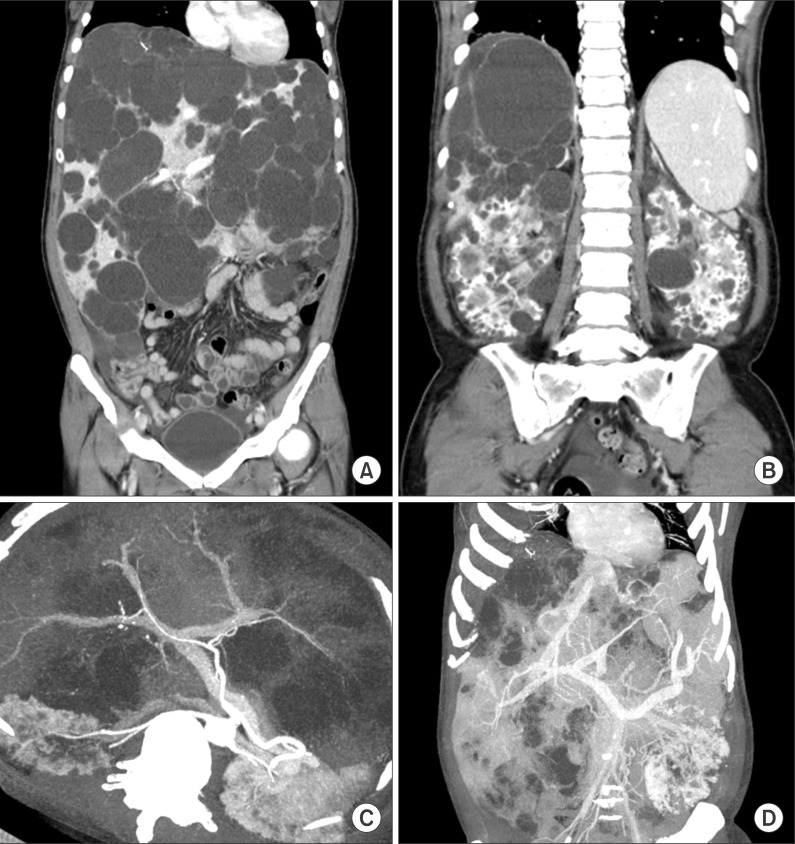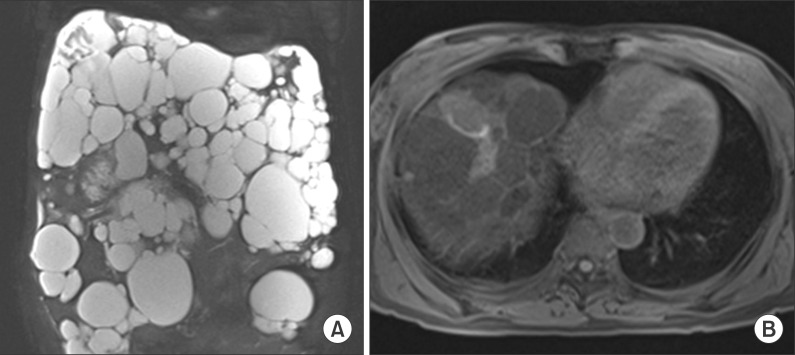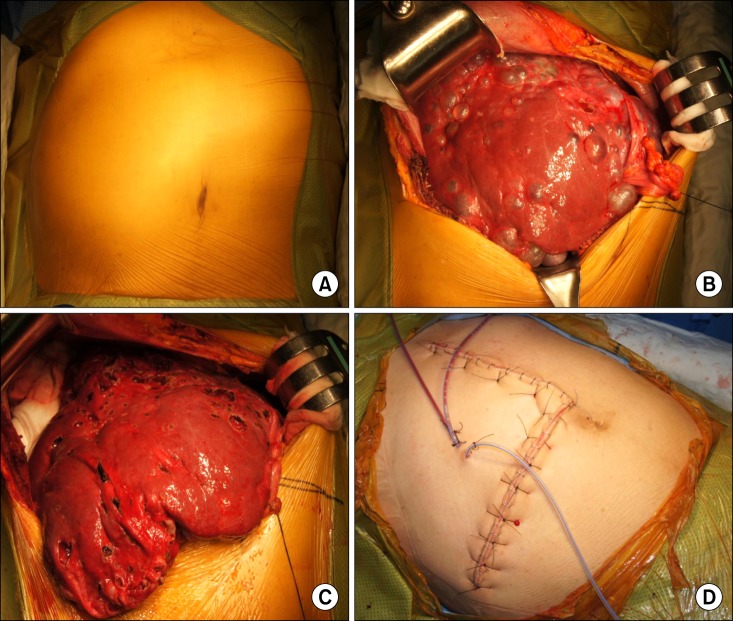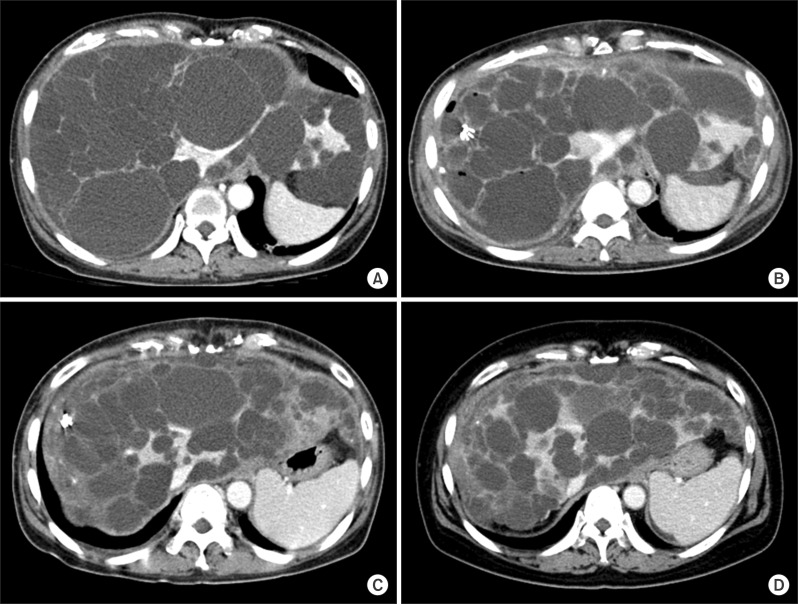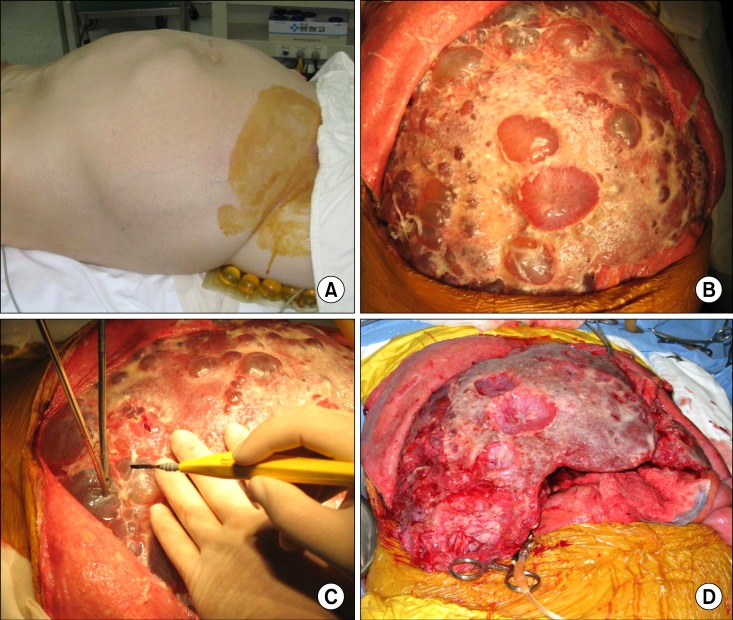Korean J Hepatobiliary Pancreat Surg.
2015 Feb;19(1):40-46. 10.14701/kjhbps.2015.19.1.40.
Fenestration of liver cysts in polycystic liver disease to improve quality of life: a case report and literature review
- Affiliations
-
- 1Division of Hepatobiliary Surgery and Liver Transplantation, Departments of Surgery, Asan Medical Center, University of Ulsan College of Medicine, Seoul, Korea. shwang@amc.seoul.kr
- KMID: 1802239
- DOI: http://doi.org/10.14701/kjhbps.2015.19.1.40
Abstract
- Polycystic liver disease (PCLD) is characterized by a large number of liver cysts scattered throughout the liver parenchyma. We herein intend to present the beneficial effect of palliative fenestration treatment on quality of life in a patient with symptomatic PCLD. A 48-year-old female patient had been followed up for 5 years for both polycystic liver and kidney diseases at another institution. During follow-up for last 1 year, we recognized that she had barely maintained her ability of function in daily activities due to progressive worsening of fatigue and dyspnea on exertion. The patient finally underwent surgical fenestration treatment. Multiple cysts in the enlarged liver were opened and the cyst walls were excised with electrocautery. No surgical complication occurred and the patient was discharged 10 days after the open fenestration surgery. The total liver volume was 3,870 ml before surgery and 3,125 ml at 1 week after surgery, showing a volume reduction of 19.3%. After surgery, her performance status improved significantly. In the present case, significant improvement in quality of life and daily activity performance was achieved after open fenestration treatment over 18 months of follow-up without disease recurrence.
MeSH Terms
Figure
Reference
-
1. Qian Q, Li A, King BF, Kamath PS, Lager DJ, Huston J 3rd, et al. Clinical profile of autosomal dominant polycystic liver disease. Hepatology. 2003; 37:164–171. PMID: 12500201.
Article2. Arnold HL, Harrison SA. New advances in evaluation and management of patients with polycystic liver disease. Am J Gastroenterol. 2005; 100:2569–2582. PMID: 16279915.
Article3. Szabó LS, Takács I, Arkosy P, Sápy P, Szentkereszty Z. Laparoscopic treatment of nonparasitic hepatic cysts. Surg Endosc. 2006; 20:595–597. PMID: 16437277.
Article4. van Keimpema L, Ruurda JP, Ernst MF, van Geffen HJ, Drenth JP. Laparoscopic fenestration of liver cysts in polycystic liver disease results in a median volume reduction of 12.5%. J Gastrointest Surg. 2008; 12:477–482. PMID: 17957434.
Article5. Everson GT, Taylor MR, Doctor RB. Polycystic disease of the liver. Hepatology. 2004; 40:774–782. PMID: 15382167.
Article6. Lin TY, Chen CC, Wang SM. Treatment of non-parasitic cystic disease of the liver: a new approach to therapy with polycystic liver. Ann Surg. 1968; 168:921–927. PMID: 5684196.7. Oken MM, Creech RH, Tormey DC, Horton J, Davis TE, McFadden ET, et al. Toxicity and response criteria of the Eastern Cooperative Oncology Group. Am J Clin Oncol. 1982; 5:649–655. PMID: 7165009.
Article8. Eypasch E, Williams JI, Wood-Dauphinee S, Ure BM, Schmülling C, Neugebauer E, et al. Gastrointestinal Quality of Life Index: development, validation and application of a new instrument. Br J Surg. 1995; 82:216–222. PMID: 7749697.
Article9. Gigot JF, Jadoul P, Que F, Van Beers BE, Etienne J, Horsmans Y, et al. Adult polycystic liver disease: is fenestration the most adequate operation for long-term management? Ann Surg. 1997; 225:286–294. PMID: 9060585.10. Qian Q, Li A, King BF, Kamath PS, Lager DJ, Huston J 3rd, et al. Clinical profile of autosomal dominant polycystic liver disease. Hepatology. 2003; 37:164–171. PMID: 12500201.
Article11. Schnelldorfer T, Torres VE, Zakaria S, Rosen CB, Nagorney DM. Polycystic liver disease: a critical appraisal of hepatic resection, cyst fenestration, and liver transplantation. Ann Surg. 2009; 250:112–118. PMID: 19561475.12. Gigot JF, Legrand M, Hubens G, de Canniere L, Wibin E, Deweer F, et al. Laparoscopic treatment of nonparasitic liver cysts: adequate selection of patients and surgical technique. World J Surg. 1996; 20:556–561. PMID: 8661625.
Article13. Giuliante F, D'Acapito F, Vellone M, Giovannini I, Nuzzo G. Risk for laparoscopic fenestration of liver cysts. Surg Endosc. 2003; 17:1735–1738. PMID: 12802647.
Article14. Konstadoulakis MM, Gomatos IP, Albanopoulos K, Alexakis N, Leandros E. Laparoscopic fenestration for the treatment of patients with severe adult polycystic liver disease. Am J Surg. 2005; 189:71–75. PMID: 15701496.
Article15. Robinson TN, Stiegmann GV, Everson GT. Laparoscopic palliation of polycystic liver disease. Surg Endosc. 2005; 19:130–132. PMID: 15531969.
Article16. Abu-Wasel B, Walsh C, Keough V, Molinari M. Pathophysiology, epidemiology, classification and treatment options for polycystic liver diseases. World J Gastroenterol. 2013; 19:5775–5786. PMID: 24124322.
Article17. Drenth JP, Chrispijn M, Nagorney DM, Kamath PS, Torres VE. Medical and surgical treatment options for polycystic liver disease. Hepatology. 2010; 52:2223–2230. PMID: 21105111.18. Que F, Nagorney DM, Gross JB Jr, Torres VE. Liver resection and cyst fenestration in the treatment of severe polycystic liver disease. Gastroenterology. 1995; 108:487–494. PMID: 7835591.
Article19. Everson GT, Taylor MR, Doctor RB. Polycystic disease of the liver. Hepatology. 2004; 40:774–782. PMID: 15382167.
Article20. Freeman RB Jr, Gish RG, Harper A, Davis GL, Vierling J, Lieblein L, et al. Model for end-stage liver disease (MELD) exception guidelines: results and recommendations from the MELD Exception Study Group and Conference (MESSAGE) for the approval of patients who need liver transplantation with diseases not considered by the standard MELD formula. Liver Transpl. 2006; 12:S128–S136. PMID: 17123284.
Article21. Arrazola L, Moonka D, Gish RG, Everson GT. Model for end-stage liver disease (MELD) exception for polycystic liver disease. Liver Transpl. 2006; 12:S110–S111. PMID: 17123287.
Article
- Full Text Links
- Actions
-
Cited
- CITED
-
- Close
- Share
- Similar articles
-
- Polycystic liver disease: an overview of clinical manifestations, diagnosis, and treatment
- Surgical Treatment of Unilobar Adult Polycystic Liver Disease
- Living donor liver transplantation for huge polycystic liver disease with recipient liver splitting method: a case report
- Portal vein fenestration: a case report of an unusual portal vein developmental anomaly
- A Case Report of Renal Cell Carcinoma in a Polycystic Kidney: A case report

